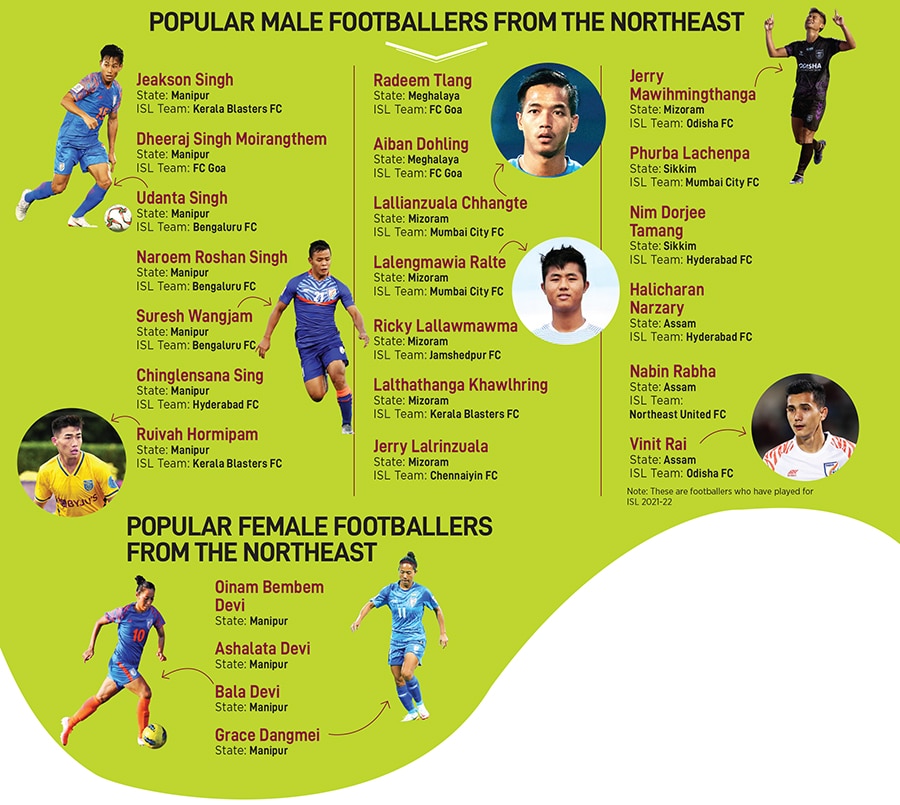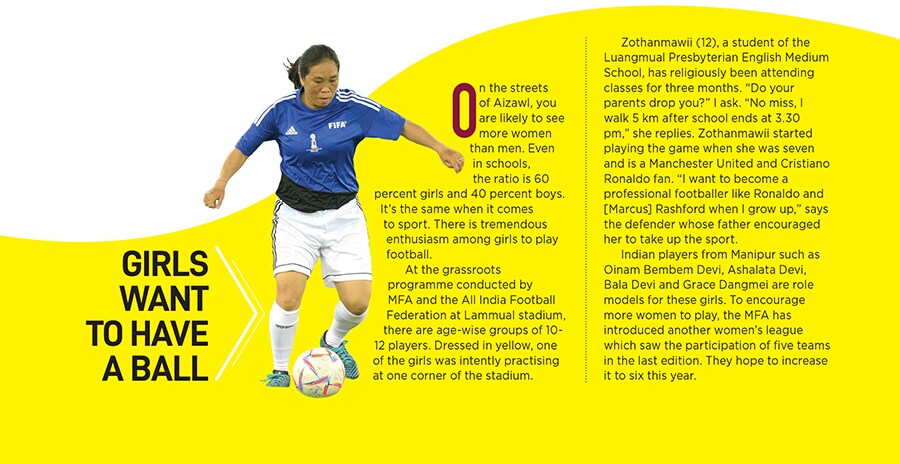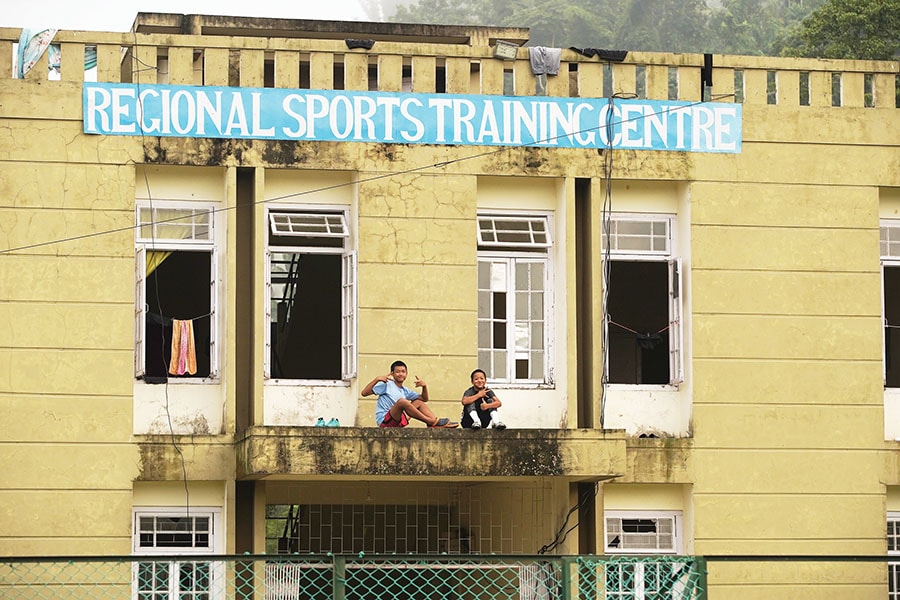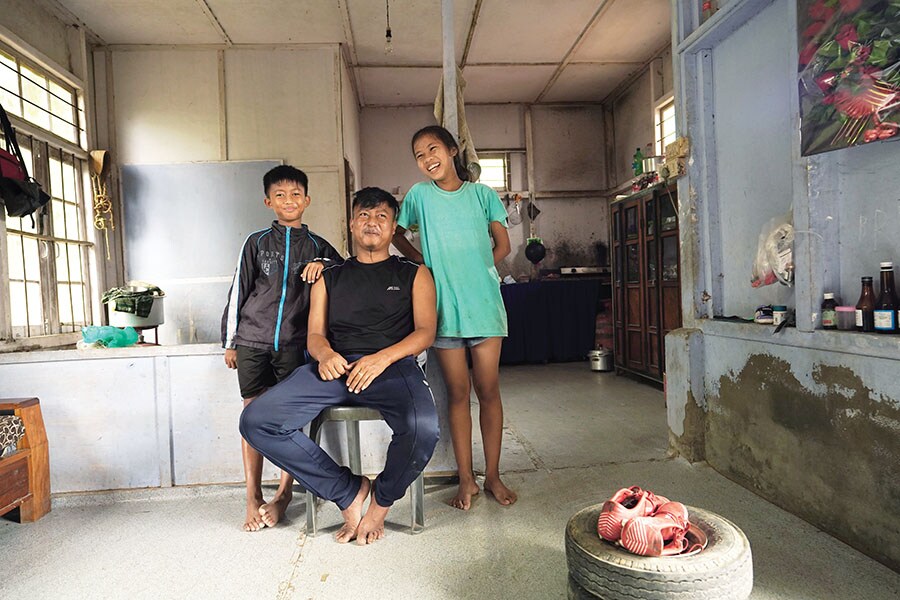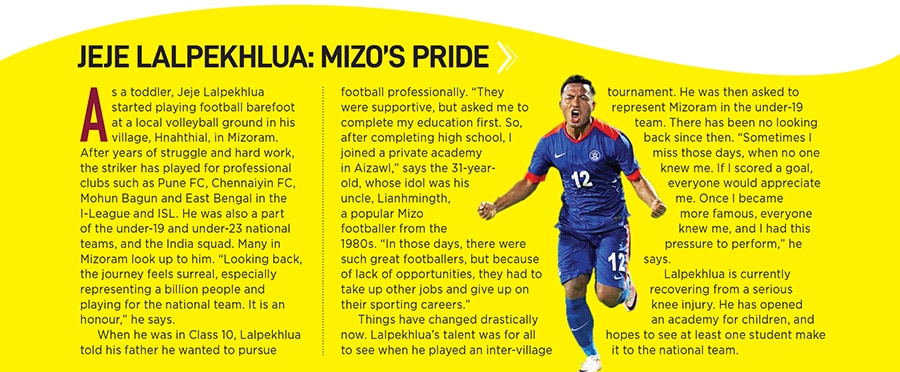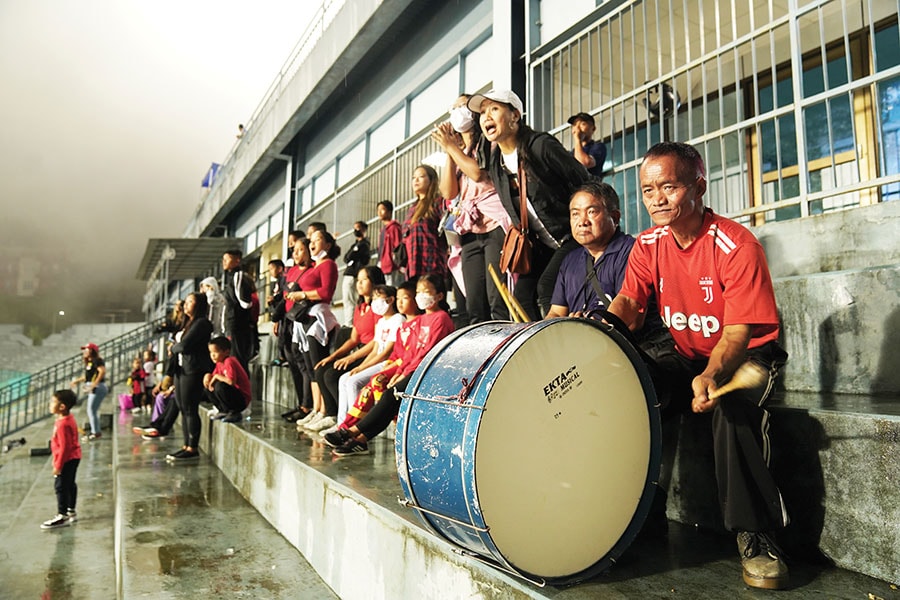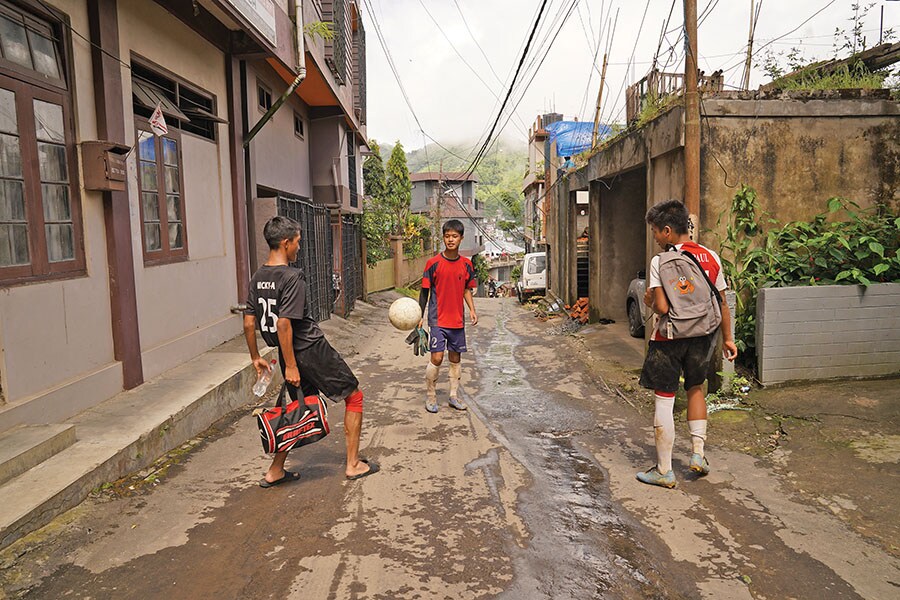Around 2.30 pm, we reach the Regional Sports Training Centre in Saidan, Kolasib—a picturesque football ground with an artificial grass turf, overlooking the city on one side and mountains on the other. Soon, young students from the academy start jostling in. Aged between 10 and 14, they are dressed in oversized jerseys, shorts that are long enough to be trousers, knee-length socks and studs. The moment the coach brings a massive net bag with 10-15 footballs, the group of 25 players run towards him, screaming with excitement. They divide themselves into smaller groups and begin practice even before the coach’s instructions.
This is just one of the many instances that depicts the passion for football, among kids and adults, not only in Kolasib and Aizawl, but across the Northeast. Though the ‘Seven Sisters’ are starkly different from each other in many aspects, the one thing in common among them is football, and how ingrained it is in their culture.
Nothing exemplifies this more than the football fervour that has gripped the region ahead of the FIFA World Cup. On the streets of Aizawl are multiple sports shops mostly selling football gear television stores are offering discounts for the World Cup and local grounds are full of men and women playing football at any time of the day.
As per news reports, in the 2021-22 Indian Super League (ISL), about 85 players were from the Northeast—43 from Manipur, and 33 from Mizoram and the rest from Meghalaya, Sikkim and Assam. While the love and passion for the sport in the region runs deep, what’s lacking is the right structure and infrastructure.
T he Mizos start playing football as toddlers. Usually one of the family members introduces them to the sport. “I think from the time my son could walk and run, he has been playing football," says Lalchawiliana, who drives a rickshaw in Kolasib.
Before football rose to popularity in the Northeast, hockey used to be extremely popular, says Lalnghinglova Hmar, honorary secretary, Mizoram Football Association (MFA). Organised football rose to popularity in the 1970s. “Apart from a few festivals and Christmas, local football was the community’s main form of entertainment. Every government department had its own team that would compete against each other. In 1984, Aizawl FC was formed," recalls Hmar, who, like most Mizo kids, grew up playing football. But with the arrival of cable television, local football took a backseat for a few years till Hmar took charge of MFA in 2011.
![]() An under-10 training session at the Lammual stadium in AizawlIamge: Mexy Xavier
An under-10 training session at the Lammual stadium in AizawlIamge: Mexy Xavier
In those days, a few players went to the Tata Football Academy in Jamshedpur and then joined clubs like Mohun Bagan and East Bengal. “Many other players who were equally good were left behind. If these players had also got good opportunities in Mizoram, there would be many more professional footballers emerging from the state," says Hmar, suggesting that launching an intra-state league seemed like the best solution.
A local television broadcaster, Zonet Cable TV Network, offered to buy the commercial rights for the league for ₹25 lakh. “The amount was beyond our wildest imagination… our budgets used to be ₹4-5 lakh per match this was the opportunity we were waiting for," says Hmar, who is popularly called Tetea Hmar.
The Mizoram Premier League (MPL) eventually started in 2012. “The format is such that footballers are forced to play constantly, instead of a one-off match. It trains them to be better professional footballers… to a point that they can play directly at an ISL match after playing at the MPL," says Zara, a sports journalist with local daily newspaper Vanglaini.
After the MPL, winning became a habit for teams from the region. In 2015, Mizoram won the gold at the National Games, beating Punjab 1-0 in the final. The same year, Aizawl FC also won the I-league 2nd Division games, making it the first football club from the Northeast to win such a top football league.
All the right teams participating in the MPL need to be backed by a certain locality, town or village. “For instance, Chanmari FC is backed by Chanmari, a locality in Aizawl. The team goes door-to-door in that community for crowdfunding. This adds a sense of ownership, the crowd/community feels this is ‘my club’. People contribute as much as they can," explains Hmar.
![]()
This sense of ownership was evident at the Rajiv Gandhi stadium during the Chanmari FC vs Venghnuai FC match on a foggy and rainy Thursday evening in September. Though it wasn’t a packed stadium, the loud chants and drums created an electrifying atmosphere. And it wasn’t just the youth… there were families, with young children, parents and grandparents, who thronged the stadium.
Interestingly, unlike the rest of India, cricket isn’t a religion here. One of the fans at the game says, “If Virat Kohli was watching the match here, I don’t think anyone would even realise."
MPL began growing within Mizoram, but no one in the region thought of taking up football professionally until Shylo Malsawmtluanga, popularly known as Mama, represented India. He became the first footballer from Mizoram to play for the national team, and clubs such as Mohun Bagan and East Bengal. Unlike earlier, parents are now more accepting of their children pursuing football as a career.
![]() Teenage hostellers relax after a practice session at the Regional Sports Training Centre in Saidan, KolasibImage: Mexy Xavier
Teenage hostellers relax after a practice session at the Regional Sports Training Centre in Saidan, KolasibImage: Mexy Xavier
“When parents see kids like Mama, Jeje [Lalpekhlua] and other such players come back from these big leagues, and see their interviews, they get motivated. They also want to send their kids for football camps/classes because they understand it can be a financially sustainable career," says Christine L Sailo, owner and vice principal of Mount Carmel School.
The state provides the football association with ₹16-17 lakh per year to run the league. However, Hmar claims it costs between ₹1 crore and ₹1.5 crore to organise the MPL, including travel, food, jerseys etc. They look for sponsors, but since there are no large corporates in Mizoram, the only option is to approach local businesses. This year, for instance, the MPL is sponsored by Zote Honda—a local Honda showroom. The downside, though, is that players aren’t paid big salaries. “Though they might not earn big money at this stage, it’s a great platform for them to prove themselves at the state level, to get more opportunities at the I-League and ISL," adds Hmar.
![]() Lalchawiliana with his daughter Vanlalnghaki (13) and son Lalthazuala (12) in their one-bedroom quarter in Kolasib district. He ensures that Lalthazuala attends football lessons thrice a weekImage: Mexy Xavier
Lalchawiliana with his daughter Vanlalnghaki (13) and son Lalthazuala (12) in their one-bedroom quarter in Kolasib district. He ensures that Lalthazuala attends football lessons thrice a weekImage: Mexy Xavier
In a tiny one-bedroom government quarter, next to the local sub-centre, is Lalchawiliana’s home. An avid footballer and a Real Madrid fan, he has been driving a rickshaw for 10 years while his wife is a health worker at the sub-centre on a 9 am-5 pm shift. Most of the household responsibilities are taken over by their 13-year-old daughter Vanlalnghaki, who also takes care of her three younger siblings after school. Lalchawiliana introduced football to his children when they were toddlers, tutoring them to play barefoot at the volleyball court next door.
He earns about ₹15,000 a month, and for most periods cannot afford to pay for football lessons for his 12-year-old son Lalthazuala. Yet, he takes him for practice thrice a week, at 6 am, picks him up by 7 am and drops him to the bus stop by 8 am. “It gets extremely hectic as the ground is very far, but I will support him 100 percent if he wants to pursue his passion for football," he says.
The paucity of quality grounds is an issue across Mizoram. If private and public schools had good grounds, parents like Lalchawiliana wouldn’t have had to struggle. However the terrain in Mizoram is such that it is hard to find large plain areas. Which is why a lot of players now train on futsal grounds that are easier to access.
![]()
Sailo of Mount Carmel School explains, “Our students love football, but no school here has a proper football ground. We have to book grounds for Saturdays and Wednesdays for them to practice. Very often, they are already booked." A school ground can be booked for ₹5,000 per day.
Every evening, the hostellers come to a smallish basketball court, use the old school benches as goal posts and play football. “Sometimes the boys don’t give girls a chance. But when the girls’ team practices, the boys cheer for them," says Sailo. The school’s girls’ team became city champions for the Reliance Foundation Youth Sports (RFYS) tournament in 2018-19. (Reliance Industries owns Network 18, the publisher of Forbes India.)
Infrastructure is just one of the concerns plaguing the sport in the region. Another is funding and interest in spending on organised football, both from private institutes and state governments. However, with talented footballers now emerging from the Northeast, governments and private institutes are encouraging people to play the game.
![]() Families with young children and grandparents cheer with chants and drums at the Rajiv Gandhi stadium during a match in SeptemberImage: Mexy Xavier
Families with young children and grandparents cheer with chants and drums at the Rajiv Gandhi stadium during a match in SeptemberImage: Mexy Xavier
Among private institutions, Reliance Foundation—run under the guidance and leadership of founder and chairperson Nita Ambani—is doing a lot of work for the development of sports. The RFYS programme started in 2016 across eight locations, including Assam, and many more in talent hotbeds such as Mizoram, Manipur and Meghalaya in 2017.
The biggest challenge at the grassroot level is that not enough children are playing football. “If you look at an Indian kid, they would be playing 14 to 20 games a year, whereas children abroad play close to 80 to 100 games annually. Football requires quick decision-making, which can be developed at a young age if they start playing more," explains a Reliance Foundation spokesperson, adding that the foundation has been focusing on introducing more competitions for children at the grassroots.
Besides organising tournaments, RFYS claims to have extended grants worth more than ₹48 lakh to schools and colleges in the region to help develop sporting activities. Of this, around ₹14 lakh was extended to institutes supporting girls’ football. “We want to go to the grassroots, work with stakeholders, develop the sport, increase participation and provide opportunities for kids. We can then include them in training programmes with the best facilities," says the spokesperson.
![]() Students of government-run Chaltlang Higher Secondary School play football on their wayhome, in AizawlImage: Mexy Xavier
Students of government-run Chaltlang Higher Secondary School play football on their wayhome, in AizawlImage: Mexy Xavier
In Mizoram, Reliance Foundation wants to run children’s leagues along with the MFA and set up a Young Champs regional centre of excellence, where some kids will be trained by quality coaches. This will bolster their chances of getting scouted by professional clubs. In Manipur, a similar RFYS programme has been running for three seasons in Imphal and surrounding districts, with more than 300 teams and over 3,600 athletes. In Meghalaya, outside of Shillong, there are other districts such as Jowai, Khliehriat, Ri Bhoi and Nongstoin with 250-plus teams and 3,000-plus athletes who have participated. One of the girls’ schools in Meghalaya, Umthli Secondary School, saw local villagers pool in money for them to train. The team won the national championship and upgraded the facilities with the prize money.
Apart from ensuring quality grounds, clean changing rooms and washrooms, Reliance Foundation also sponsors free certifications for physical education teachers to get a football licence. “The idea is to focus on the sustainable development of the ecosystem at the grassroots," says the spokesperson.
The government too has been doing its bit. One such initiative is the Regional Sports Training Centre in Saidan, Kolasib, where several athletes train. Lalchhuanawma, 13, a talented footballer has made it to its residential programme. He trains from 5 am to 7.30 am, following which he attends school closeby. Between 3 pm and 5.30 pm, he is at the ground again after which he studies post-dinner. “It gives us a lot of exposure and helps us understand how to deal with success and failure," says the defender, who recently played in the Subroto Cup. Some of the players at the academy have given two to four trials for the under-13 and under-17 teams of Bengaluru FC, Hyderabad FC and Madras FC.
While the academy only encourages the best talent in Mizoram, it also emphasises on the importance of education. “Everyone can’t become a Jeje or Mama. If they can become popular footballers, great… if not, they still have education to fall back on," says Hmar.
![]()
Despite the challenges, there is nothing that can come in the way of Mizos and football. A father of two sons, aged six and nine, says, “If it’s raining or for some reason, the academy cancels football classes, my children get very upset. They will find some way to spend an hour playing football, either in our home or in the local ground."
Mizoram might be a case study, but the football craze resonates across the Northeast. People have taken a liking to other sports—basketball, volleyball, futsal and even cricket in certain pockets—too, but their loyalty to football is unmatched. “Even if you start fining people for playing football, they will still play, come what may," says Hmar.

